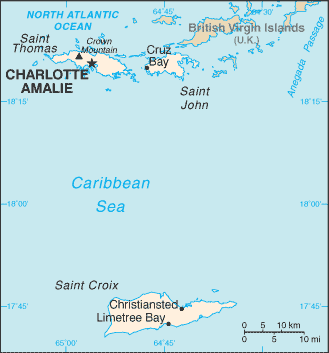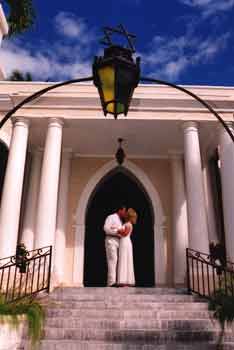Virgin Islands Virtual Jewish History Tour
 |
Jews first settled in the Virgin Islands in 1655 when it was ruled by Denmark. These were mainly traders in sugarcane, rum and Molasses. One of the first Jews in the Virgin Islands was Gabriel Milan, whom King Christian of Denmark sent in 1684 to be governor, the first of three Jews who have served as governors.
In 1685, the Jews and Catholics were granted freedom of religion and about two centuries later, in 1850, the Islands’ Jewish population hit its peak, numbering 400 and making up half of the white community.
After the opening of the Panama Canal in 1914, the number of Jews declined rapidly and, by 1942, only 50 Jews remained. Since then the community has rebounded and is roughly the size it was at its peak.
In 1796, the Jews of St. Thomas founded a synagogue that is now considered the oldest continuous-use synagogue under the American flag (the Virgin Islands are an American territory).
In 1801, only nine Jewish families belonged to the congregation but, by 1803, this number had increased to 22, with arrivals from England, France, and the Caribbean islands of St. Eustatius and Curacao. In 1804, the small synagogue was destroyed by fire but was quickly replaced a few years later in 1812.
Soon, the congregation grew so large that, by 1823, it was dismantled and a larger building erected in the same location on Synagogue Hill. It was named the Congregation of “Blessing and Peace and Loving Deeds.” The Congregation numbered 64 families when a city-wide fire destroyed the synagogue in 1831.
|
|
The present-day synagogue building was built in 1833 with the help from worldwide Jewry and the entire island community. Shabbat religious services have been held there every week since 1833 with only one exception: September 15, 1995, when Hurricane Marilyn devastated the island.
The synagogue, known as Congregation Beracha Veshalom Vegmiluth Hasadim, was built in the traditional Sephardic style since its original congregants migrated as a result of the Spanish Inquisition. In Sephardic architecture, the seating permits congregants to face one another instead of theater-style as in Ashkenazic and most stateside synagogues. Also in keeping with Sephardic architecture, the bimah, where the rabbi or reader stands, is opposite the arc in which our six Torahs are housed.
Everything in the historic St. Thomas Synagogue building is original, dating to 1833. The benches, the ark and the bima are all made from mahogany that used to flourish on the islands. The menorah behind the bima is of Spanish origin and dates to the 11th century. The chandeliers are from Europe, probably Holland. The central fixture with nymphs looks French in design and each lamp is made of Baccarat crystal. The peripheral chandeliers have since been electrified but the central ones are still lit by candles on important holidays. Originally all the chandeliers were lit with oil.
The walls are specially designed to be fireproof (because the building was built of bricks and stone rather than wood) and hurricane-proof, as are the windows. They allow for a free passage of air while blunting some of the force of the wind. The stones are locally quarried but the bricks came from Europe.
The huge sailing ships that arrived from Europe had relatively little to sell on the island and filled their hulls with the bricks for use as ballast. Once the ships arrived in St. Thomas, the bricks were unloaded and used for local building needs while the ships took the locally produced rum and sugar back to Europe. The cement that holds the bricks together is a mortar made from sand, limestone and molasses. It is said that in the earlier years, children used to lick the walls of the synagogue to taste the sweet molasses. (However, that sounds like legend because the walls originally were covered with plaster.)
The four pillars that support the building symbolize the four matriarchs in Judaism – Sarah, Rachel, Rebecca and Leah. These pillars, like those at the entrance to the building, were handmade in Denmark especially for the synagogue from rounded bricks.
Another unusual feature of the synagogue is its sand floor. According to legend it is symbolic of the desert through which Moses and the children of Israel wandered for 40 years. The more likely explanation has to do with the fact that this was originally a Sephardic Orthodox community. During the Spanish Inquisition, when Catholic Spain persecuted all other religions and forcibly converted the Jews to Catholicism, Jews who opted to practice Judaism – an offense punishable by death – had to do so in secrecy. They met in cellars of their homes and used sand to muffle the sounds of their prayer.
With time, years of rain and moisture penetration into the walls, coupled with low maintenance of the building, caused some of the plaster to peel off, only to show underneath a beautiful stone wall. In 1973, the congregation arranged to strip the remains of the damaged white plaster and bring to the fore the brick and stone walls of the synagogue. More than 25 years later, it was discovered that the plaster on the walls was not only considered the epitome of beauty in 1833 but also served an important function. It acted as a skin on a body, allowing the walls to breathe and dry the absorbed moisture without losing any of the wall.
Today, the synagogue is affiliated with the Reform movement. The low wooden walls in the synagogue served as a mechitzah to separate the women from the men during the early years when the congregation was Orthodox. Since the synagogue is the only one on the island, it serves the religious needs of a diverse Jewish population. The first confirmation ceremony in the Western Hemisphere took place at the synagogue on October 14, 1843.
In the year of the Bicentennial, 1995-96, a small museum was added to the synagogue, named after the late Johnny Weibel, a member of the congregation. The museum tells the history of the congregation and the synagogue, and displays some of the artifacts related to the Jewish history on the island.
The Altona Cemetery is one of two historic cemeteries owned and maintained by the Hebrew Congregation of St. Thomas.
In 1938, and again in 1940, the Virgin Islands offered to take in Jews fleeing the Nazis. With President Roosevelt’s assent, however, the State Department barred their entry.
A number of famous Jews have been born in the Virgin Islands, including French impressionist painter Camille Pissarro and David Levy Yulee, Florida’s first senator.
Israel’s consul general in New York, Ambassador Dani Dayan, became the first Israeli representative to make an official visit to the U.S. Virgin Islands in August 2018. Dayan visited St. Thomas and engaged with the local Jewish community. A photo of Dayan holding the Torah of Congregation Beracha Veshalom Vegmiluth Hasadim was featured as the cover story on the Virgin Islands Daily News newspaper, highlighting the significance of his visit.
Sources: St. Thomas Synagogue
Encyclopedia Judaica. CD-ROM 1996.
Michael Zaidner (ed.). Jewish Travel Guide 2000. Vallentine Mitchell& Co. 2000.
Julie Kay, "Synagogues in the Sand." The Forward (March 2, 2012);
Nathan Guttman. Ravaged By Irma, Virgin Islands Synagogue Holds Shabbat Service To Extend 200-Year Tradition,
Forward, (September 11, 2017);
Dani Dayan, An Israeli Ambassador Makes History in the Caribbean,
Tablet, (August 13, 2018).
Photo Credits: St. Thomas Synagogue.
CIA.




